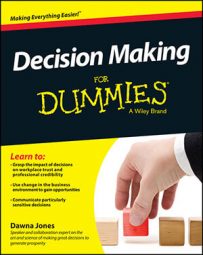After you gather information, the next step is to make sense of it. In short, it’s time to analyze the data. Factors that determine how you’ll proceed include how much time is available and whether you need to justify your decision to investors, customers, employees, or shareholders.
Follow these steps to sort and analyze the information you’ve gathered:
Identify the facts, data, and raw numbers relevant to the decision and determine how you’ll crunch the numbers so they can inform the decision or selection of options.
Big data is the term given to the proliferation and abundance of data decision-makers must consider. Computer programs available for analyzing complex data include spatial, visual, or cloud-based presentations.
Sort the social and emotional information into themes.
The themes can be trends (the direction for societal preferences), dynamics (the interrelationships that exist), and needs or preferences (which point to the underlying values that inform decisions), for example.
These things tell you about what lies ahead so that you can predict what the response will be to your decision. Use them as a lens to identify what you need to consider in choosing options, or to ensure that you meet social and emotional needs during the implementation process.
Identify the considerations you see as relevant to either making the decision or implementing it.
To synthesize what’s important to consider in your decision-making, explore the facts (the rational-logical portion) and what is going on in the situation (feelings/emotions or relationships/social). Pull out the main ideas to use in subsequent steps. You can either use a mind map, a method to visually map related ideas, or you can tuck related ideas under the key points so you can see the relationships between the information you’ve gathered.
For example, if you’re launching into a new market, as Target recently did into Canada, you’d want to ask Canadian customers what Target products they prefer. Customer preferences would be a theme; the product, price point, and customer expectations for service would form a part of the background decision-making.
Map out consequences — how the decision will impact staff, customers, employees, and suppliers, for example.
Knowing the consequences helps you make adjustments and informs what and how you’ll communicate any changes to your listeners, based on what they currently expect or are familiar with.
If you are using a rational decision-making process, select criteria you’ll use to consider options before making a final selection.
You need to identify the criteria you’ll use to assess the options under consideration.
By now, you’ll know which information is most relevant, whether you’re relying exclusively on analysis of the data or combining it with your intuitive know-how. If you’re making your decision purely intuitively, you’ll use what you perceive to be important and will rely on how the data is presented to pull out key points.
Throughout your analysis, keep communicating with your team. Doing so not only helps everyone know what is going on, but it also encourages dissenting views and alternative perspectives to come forward.

